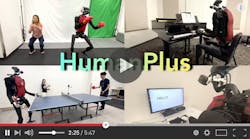Fun Innovations Friday: Robot Can Be Your Body-Double With Just 40 Hours of Learning
I grew up with the Disney Channel's prime era of Disney Channel Original Movies or DCOMs, and one of those movies was called The Other Me. In it, a boy somehow clones himself and decides that he can have the clone do all the things he doesn't want to do, like go to school, while he can stay at home and vegetate all day.
While back then that was considered an out-there fantasy, it's now becoming a reality. Alexis Gajewski, senior editor and content strategist of Plant Services, recently reported on a robot that can learn your movements and mimic them. Pretty cool.
Below is an excerpt from her blog post:
A team of researchers at Stanford University have engineered and constructed the HumanPlus robot, which is designed to shadow the movements of humans. The team, which consists of Zipeng Fu, Qingqing Zhao, Qi Wu, Gordon Wetzstein, and Chelsea Finn, documented their journey in a recently published paper titled “HumanPlus: Humanoid Shadowing and Imitation from Humans.”
According to the team, they used 40-hour human motion datasets to teach the robot how to perform an array of activities that includes playing ping pong, boxing, typing on a keyboard, playing the piano, and more.
But the HumanPlus robot does more than just mimic human movements. It can actually learn the movements. According to the team, “Using the data collected, we then perform supervised behavior cloning to train skill policies using egocentric vision, allowing humanoids to complete different tasks autonomously by imitating human skills. We demonstrate the system on our customized 33-DoF 180cm humanoid, autonomously completing tasks such as wearing a shoe to stand up and walk, unloading objects from warehouse racks, folding a sweatshirt, rearranging objects, typing, and greeting another robot with 60-100% success rates using up to 40 demonstrations.”
